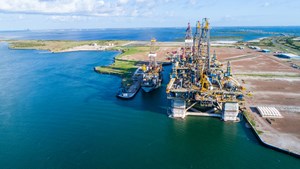Biden administration to sell new oil leases while nurturing offshore wind and carbon capture opportunities
(Bloomberg) — The U.S. government is moving urgently to nurture new offshore wind and carbon capture and storage (CCS) industries despite some economic hurdles, according to the nation’s newly minted ocean energy regulator.
The tasks of overseeing the buildout of those nascent industries falls to Liz Klein, an environmental lawyer and clean energy champion who was recently appointed Director of the Bureau of Ocean Energy Management.
Klein takes over at a critical time, as her agency makes decisions about where to install ocean wind farms, how to safely store carbon dioxide under the sea floor and the future of oil drilling in the Gulf of Mexico.
“The president has been clear that we are in a climate crisis, we have a responsibility as the federal government to do something about that and we can turn that into an opportunity to transition to cleaner sources of energy,” Klein told Bloomberg in her first interview in the new role. At the same time, the focus will be on doing it in a “way that really supports communities” while tapping American smarts and innovation, she added.
Those opportunities converge in the Gulf of Mexico. The bureau is on track to sell the first-ever offshore wind development rights in the Gulf later this year. And it’s writing rules that will govern the storage of carbon dioxide under the sea floor — including how the government makes the area available to companies eager to take advantage of newly expanded tax credits to pump captured emissions underground.
Meanwhile, the agency is working to finalize an overdue five-year plan for offshore oil leasing and hold two auctions of drilling rights in the Gulf of Mexico that were mandated by the sweeping climate-and-tax law enacted by President Joe Biden last year. The administration’s initial offshore oil leasing proposal left open the possibility the government could hold as many as 11 auctions in U.S. coastal waters between mid-2023 and mid-2028 — or none at all.
Under the Inflation Reduction Act, the government’s ability to issue renewable energy rights is tied to the sale of oil leases — potentially forcing some of those auctions. “We have new statutory requirements” so that “if we are to continue offshore wind leasing, we also need to continue offshore oil and gas development,” Klein said.
Klein is consulting with counterparts in other countries to swiftly establish a new regulatory regime overseeing carbon storage under the ocean floor. With carbon capture and storage initiatives supercharged by the Inflation Reduction Act, and just a few offshore storage projects globally — in the North Sea — it’s a chance to cultivate a brand-new industry in the U.S.
The opening may be greatest in the Gulf of Mexico, which has for decades been a hub of U.S. offshore oil development — providing about 15% of domestic production. In contrast to other U.S. waters, there’s more data about the ocean bottom and what lies beneath it, as well as a chance to leverage the existing network of subsea pipelines and their proximity to petrochemical facilities in Louisiana and Texas.
“It presents a great opportunity,” Klein said. “It is the perfect example, in many ways, of what the president talks about when he says we have an opportunity to turn this climate crisis into job growth, economic development and supporting communities.”
Klein said she remains “aggressively positive” about offshore wind’s potential U.S. buildout, even as mounting supply chain and inflation woes threaten to delay or derail some projects. Concerns about the industry’s impacts on fishing and endangered whales also bedevil its prospects.
Any new energy development can expect challenges, but the U.S. has the tools and innovative chops to work through them, Klein said. "Very smart engineers and scientists" are "committed to see this happen."



